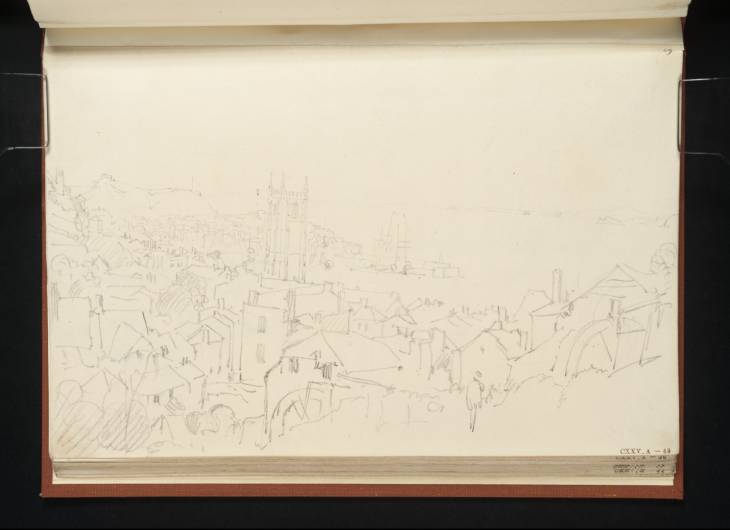Joseph Mallord William Turner St Ives from the Stennack 1811
Joseph Mallord William Turner,
St Ives from the Stennack
1811
Joseph Mallord William Turner 1775–1851
Folio 49 Recto:
St Ives from the Stennack 1811
D41328
Turner Bequest CXXV a 49
Turner Bequest CXXV a 49
Pencil on white wove paper, 141 x 215 mm
Faint embossed stamp ‘BATH | [crown] | VELLUM’ within oval cartouche
Inscribed by C.F. Bell in pencil ‘49’ top right
Blind-stamped with Turner Bequest monogram bottom right
Stamped in black ‘CXXV.A – 49’ bottom right
Faint embossed stamp ‘BATH | [crown] | VELLUM’ within oval cartouche
Inscribed by C.F. Bell in pencil ‘49’ top right
Blind-stamped with Turner Bequest monogram bottom right
Stamped in black ‘CXXV.A – 49’ bottom right
Accepted by the nation as part of the Turner Bequest 1856
Exhibition history
2006
Light into Colour: Turner in the South West, Tate St Ives, January–May 2006, Plymouth City Museum and Art Gallery, May–August (not in catalogue)
2008
Dawn of a Colony: Picturing the West, St Ives 1811–1888, Tate St Ives, May–September 2008 (no catalogue).
References
1974
Gerald Wilkinson, The Sketches of Turner, R.A. 1802–20: Genius of the Romantic, London 1974, reproduced p.128.
1977
Gerald Wilkinson, Turner Sketches 1789–1820, London 1977, reproduced p.130.
1984
Tom Cross, Painting the Warmth of the Sun: St Ives Artists 1939 – 1975, Penzance and Guildford 1984, p.10.
1984
Peter Davies, The St Ives Years: Essays on the Growth of an Artistic Phenomenon, Wimborne 1984, pp.6, 9 note 1, as ‘view of St Ives from the Stennack’.
1985
David Brown, ‘Introduction’ in Cornwall 1925 – 1975: ‘a sense of place ... a sense of light’, exhibition catalogue, Michael Parkin Fine Art, London 1985, p.[5].
1985
David Brown, ‘Chronology’ in David Lewis and David Brown, St Ives 1939–64: Twenty Five Years of Painting, Sculpture and Pottery, exhibition catalogue, Tate Gallery, London 1985, p.97.
1987
Roy Ray, ‘A Brief History of the St Ives Art Colony’ in Henry C. Gilbert, Roy Ray and Colin Orchard, Art about St. Ives, St Ives [1987], p.7, reproduced p.[6] (detail).
1989
Junichi Shioda, Masako Shimizu, Nozomi Endo and others (eds.), St. Ives, exhibition catalogue, Hyogo Prefectural Museum of Art, Kobe 1989, reproduced p.169.
1993
Michael Tooby, Tate Gallery St Ives [and] Barbara Hepworth Museum and Sculpture Garden: An Illustrated Companion, London 1993, reproduced p.15, as from the ‘Bude to Clovelly’ sketchbook.
1994
Tom Cross, The Shining Sands: Artists in Newlyn and St Ives 1880–1930, Tiverton and Cambridge 1994, p.11.
2008
David Tovey, St Ives Art pre-1890: The Dawn of the Colony, Tewkesbury 2008, p.13.
Turner looks north-east, down past the parish church of St Ia to the harbour, where Smeaton’s Pier has since been extended to about double the length shown here. The Island’s chapel stands on the summit towards the left, and Godrevy Island is seen across St Ives Bay to the right with the coast towards Newquay beyond. Many of these features appear in another drawing made from south of the town (folio 50 recto; D41329). In the foreground are watermills on the River Stennack, since culverted on its approach to the sea, about where Trenwith Place now stands above the Royal Cinema; the one in the centre has been identified by David Tovey as Chellew’s Mills.1 The building beyond it, below the church tower, appears to be the present Western Hotel in Royal Square.
This is one of four consecutive, detailed drawings of St Ives and its surroundings (see also folios 47, 48 and 50 recto; D41326, D41327, D41329), the identification of which has been credited to the contemporary St Ives artist Roy Ray;2 there is a further view bound towards the end of the book (folio 82 recto; D41364).
As discussed in the introduction, the pages of this ‘sketchbook’ appear to have originally been loose sheets, and are not recorded in Finberg’s 1909 Inventory of the Bequest, although he subsequently noted the subject mistakenly as ‘Penzance (?)’ in a manuscript listing,3 while C.F. Bell described it in his own notes as ‘Seaport town with church with square tower’.4 Figures usually corresponding to Finberg’s MS catalogue page numbers, which differ from Bell’s sequence, are inscribed on the verso of most sheets.
Tovey 2008, p.13; see also p.24, comparing Frederick Mercer’s 1870s watercolour from a similar viewpoint (fig.1.15).
A.J. Finberg, MS addenda, [circa 1928–39], tipped into a copy of his A Complete Inventory of the Drawings of the Turner Bequest, London 1909, Tate Britain Prints and Drawings Room, vol.I, opposite p.356, as CXXV(a) 28.
Technical notes:
The sheet is slightly wrinkled, possibly as a result of exposure to damp.
Verso:
Blank, save for inscription by Edwin Fagg in pencil ‘126 | 28’ bottom right. There are glue stains at the corners of the sheet.
Matthew Imms
July 2011
How to cite
Matthew Imms, ‘St Ives from the Stennack 1811 by Joseph Mallord William Turner’, catalogue entry, July 2011, in David Blayney Brown (ed.), J.M.W. Turner: Sketchbooks, Drawings and Watercolours, Tate Research Publication, December 2012, https://www

